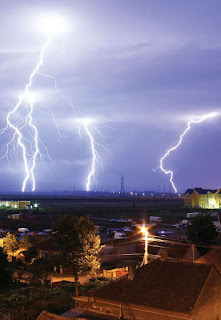Does Ball Lightning Exist?
More than 200 years ago, the crew of the HMS Warren Hastings reported being attacked by giant balls of fire that descended from the sky. The mysterious fireballs reportedly set the ship on fire and killed several people. A century later, a “dazzling globe of electric fire” appeared in the cottage where British occultist Aleister Crowley was staying, which he described in detail in his autobiography. He claimed that the floating orb instantly exploded, slightly shocking his hand. Frightening, cryptic, and potentially dangerous, this phenomenon is known today as ball lightning.
Sightings of mysterious floating balls of light have captivated humanity across many different cultures, inspiring a myriad of fantastical explanations and mythical stories. In Australian Outback folklore they are called Min Min lights—strange fuzzy balls of light that follow people around at night. The Japanese hitodama are ghostly balls of fire thought to be the apparitions of souls separated from their physical bodies after death. In English folklore they are called will-o’-the-wisps, interpreted to be mischievous fairies who try to lead travelers astray. Scientists have found possible explanations for many of them: some believe that Min Min lights are just mirages of artificial lights projected across long distances, while will-o’-the-wisps have been mainly attributed to a chemical reaction from organic decay in swamps. The mysterious ball lightning is another such phenomenon that has captured the attention of scientists, but, unlike the will-o’-the-wisp, it has mostly eluded obvious explanation for its existence. While there are many theories that try to explain its formation, some argue that the phenomenon is no more than a hallucination and thus a product of the overactive imagination of its observers.
Ball lightning, according to observers, manifests as a bright hissing orb of lightning ranging from 1 to 100 centimeters in diameter that appears during thunderstorms, often levitating above the ground and moving regardless of wind intensity or direction. Often colored red, orange, yellow, or blue, ball lightning has been described as sometimes entering buildings and exploding, lighting the area on fire or even injuring people in its vicinity. Many observers also note a distinct sulfurous smell upon its disappearance. The phenomenon has been described across the world. An engraving on the doors of the Golden Temple in Amritsar, India, describes how a ball of lightning entered and exploded inside the temple, witnessed by hundreds of worshippers. Tsar Nicholas II of Russia described an encounter in which a fiery ball of lightning flew into his room. Ball lightning once again appeared and was documented by a storm-observing team in Qinghai, China, in 2012. Despite the number of occurrences, photo and video evidence of ball lightning is extremely rare. Lab attempts to recreate and explain ball lightning have not been entirely successful, though some are promising.
The lack of concrete evidence of ball lightning’s existence has led some researchers to question ball lightning’s existence beyond anecdotes. A study in 2010 suggested that electrical currents caused by lightning can affect visual perception, with observers often reporting seeing moving luminous disks after exposure to shock. While this could certainly explain why ball lightning is most often seen during thunderstorms or after lightning strikes, it does not explain reports where multiple eyewitnesses describe the same details or when ball lightning has caused physical damage to its surroundings upon exploding. Visual perception also does not account for other sensations, such as the common description of the sulfur-like smell of ball lightning after it disappears.
If ball lightning does exist, scientists don’t have consensus on how or why it does. There are many competing theories that attempt to decipher the nature of ball lightning. One of the more significant studies was carried out by Russian researcher Pyotr Kapitsa, who proposed that ball lightning was caused by standing waves of electromagnetic radiation, though this theory has been critiqued and questioned by other scientists. Other proposals for ball lightning’s fundamental definition range from microwave radiation trapped in plasma to nanobatteries formed from aerosol particles. One of the most fascinating instances of ball lightning research occurred when it was considered as a type of weapon. In the 1960s the U.S. government researched the possibility of harnessing the energy of ball lightning to develop a plasma weapon. In the early 2000s the Missile Defense Agency funded the development of a ball lightning weapon that would have the capacity to disable electronic devices and missiles. As of 2020, however, such a weapon does not exist.
Ball lightning has simultaneously captured people’s imagination and circumvented a clear scientific explanation for centuries. Although we don’t understand it, it’s not actually uncommon to see ball lightning—some statistics state that its occurrence rate is the same as regular lightning strikes. In this era of nearly ubiquitous cameras, hopefully there will be more evidence to analyze and debate.




Comments
Post a Comment